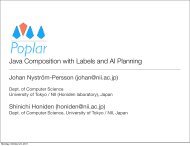all FREECO11-workshop-papers.pdf - trese
all FREECO11-workshop-papers.pdf - trese
all FREECO11-workshop-papers.pdf - trese
Create successful ePaper yourself
Turn your PDF publications into a flip-book with our unique Google optimized e-Paper software.
from WebDSL code. A second code generator then merges (superimposes)partial classes and operations and produces the finalcode in the target language. Again, this is essenti<strong>all</strong>y the same asour approach. However, because Stratego/XT does not provide anydirect support for aspect-oriented transformations or code generations,Hemel et al. needed to introduce an explicit new intermediarylanguage, containing a large set of constructs only relevant for thesubsequent superimposition (e.g., @Class for representing a partialclass). Their approach is eased by the use of Stratego/XT, wheregenerated code is always handled as an abstract syntax tree ratherthan plain text. Instead, in our approach, code is generated as text,which is then merged in a separate step. This requires this text tobe parsed again in preparation for merging, making our approachperhaps a little less time efficient. At the same time, however, italso <strong>all</strong>ows the use of simpler textual merges based on the sameinfrastructure.5. CONCLUSIONSIn this paper, we have proposed an approach applying notions ofsymmetric aspects to the domain of code generation. This approachseparates the specification of code generators from the specificationof their composition, providing more flexibility in choosing codegenerators that should be used for a particular generation task. Becauseit is a symmetric approach, it does not require any templateto be identified as the base template, enabling us to flexibly leaveout or re-arrange code generators as required. Because the weavinghappens at the level of generated code, there is no need for scaffoldingin the form of empty generator rules. Because we use syntacticmerging, the approach can take into account syntactic constraints ofthe language of the generated code. We have successfully appliedour approach to the generation of EJB code from a class model [17],and are looking to further evaluate it with more case studies as wellas in a comparative study with other generation approaches.AcknowledgementsThis work has been funded by the European Commission underFP6 STREP AMPLE and FP7 Marie-Curie IEF RIVAR. The authorswish to thank Dimitrios Kolovos, Louis Rose, and RichardPaige for help with and discussion about the Epsilon framework,and Jon Whittle for useful feedback on an earlier draft.6. REFERENCES[1] Sven Apel, Christian Kästner, and Christian Lengauer.FEATUREHOUSE: Language-independent, automatedsoftware composition. In Stephen Fickas, Joanne Atlee, andPaola Inverardi, editors, Proc. 31st Int’l Conf. on SoftwareEngineering (ICSE’09), pages 221–231. IEEE ComputerSociety, 2009.[2] Ruzanna Chitchyan, Phil Greenwood, Americo Sampaio,Awais Rashid, Alessandro Garcia, and Lyrene Fernandesda Silva. Semantic vs. syntactic compositions inaspect-oriented requirements engineering: An empiricalstudy. In Proc. 8th ACM Int’l Conf. on Aspect-OrientedSoftware Development (AOSD’09), pages 149–160. ACM,2009.[3] Eclipse Foundation. Eclipse web site. Published on-line:http://www.eclipse.org/.[4] Sven Efftinge, Peter Friese, Arno Haase, Dennis Hübner,Clemens Kadura, Bernd Kolb, Jan Köhnlein, Dieter Moroff,Karsten Thoms, Markus Völter, Patrick Schönbach, MoritzEysholdt, and Steven Reinisch. openarchitectureware xpanddocumentation. Published on-line:http://www.openarchitectureware.org/pub/documentation/4.3.1/html/contents/core_reference.html#xpand_reference_introduction, 2009.[5] William H. Harrison, Harold L. Ossher, and Peri L. Tarr.Asymmetric<strong>all</strong>y vs. symmetric<strong>all</strong>y organized paradigms forsoftware composition. Technical Report RC22685, IBMResearch, 2002.[6] Zef Hemel, Lennart C. L. Kats, Danny M. Groenewegen, andEelco Visser. Code generation by model transformation: Acase study in transformation modularity. Software andSystems Modelling, 9(3):375–402, June 2010. Publishedon-line first at www.springerlink.com.[7] Frédéric Jouault, Jean Bézivin, and Ivan Kurtev. TCS: ADSL for the specification of textual concrete syntaxes inmodel engineering. In Stan Jarzabek, Douglas C. Schmidt,and Todd L. Veldhuizen, editors, Proc. 5th Int’l Conf. onGenerative Programming and Component Engineering(GPCE’06), pages 249–254. ACM, 2006.[8] Dimitrios Kolovos, Richard Paige, Louis Rose, and FionaPolack. The Epsilon Book. Published on-line: http://www.eclipse.org/gmt/epsilon/doc/book/,2009.[9] Tom Mens. A state-of-the-art survey on software merging.IEEE Transactions on Software Engineering, 28(5):449–462,2002.[10] Jon Oldevik and Øystein Haugen. Higher-ordertransformations for product lines. In Tomoji Kishi and DirkMuthig, editors, Proc. 11th Int’l Software Product Line Conf.(SPLC’07), pages 243–254. IEEE Computer Society, 2007.[11] Jon Oldevik, Tor Neple, Roy Grønmo, Jan Aagedal, andArne-J. Berre. Toward standardised model to texttransformations. In A. Hartman and D. Kreische, editors,European Conf. on Model Driven Architecture – Foundationsand Applications (ECMDA-FA’05), pages 239–253, 2005.[12] Louis M. Rose, Richard F. Paige, Dimitrios S. Kolovos, andFiona A. Polack. The Epsilon generation language. In InaSchieferdecker and Alan Hartman, editors, Proc. 4thEuropean Conf. on Model Driven Architecture(ECMDA-FA’08), pages 1–16. Springer, 2008.[13] Dave Steinberg, Frank Budinsky, Marcelo Paternostro, andEd Merks. EMF: Eclipse Modeling Framework.Addison-Wesley Professional, 2nd edition, 2009.[14] Jonne van Wijngaarden and Eelco Visser. Programtransformation mechanics: A classification of mechanismsfor program transformation with a survey of existingtransformation systems. Technical Report UU-CS-2003-048,Institute of Information and Computing Sciences, UtrechtUniversity, May 2003.[15] Markus Völter and Iris Groher. Handling variability in modeltransformations and generators. In Proc. of the 7th OOPSLAWorkshop on Domain-Specific Modeling, 2007.[16] Jules White, Jeff Gray, and Douglas C. Schmidt.Constraint-based model weaving. Transactions onAspect-Oriented Software Development, Special Issue onAspects and Model-Driven Engineering, 5560(6):153–190,2009.[17] Steffen Zschaler and Awais Rashid. Symmetriclanguage-aware aspects for modular code generators.Technical Report TR-11-01, King’s College London,Department of Informatics, 2011.




